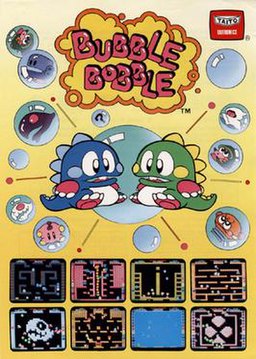Bubble Bobble
From Wikipedia, the free encyclopedia
| This article needs additional citations for verification. Please help improve this article by adding reliable references (ideally, using inline citations). Unsourced material may be challenged and removed. (March 2009) |
|
Bubble Bobble
|
|
|---|---|
 Promotional USA flyer for the original arcade iteration of Bubble Bobble |
|
| Developer(s) | Taito |
| Publisher(s) | Taito and Romstar |
| Designer(s) | Fukio Mitsuji |
| Platform(s) | Arcade |
| Release date(s) | 1986 |
| Genre(s) | Platform game |
| Mode(s) | Up to 2 players simultaneously |
| Input methods | Joystick (2-way); 2 buttons |
| Cabinet | Upright |
| Display | Raster, standard resolution 256×224 (horizontal), 256 colors |
Bubble Bobble (バブルボブル Baburu Boburu) is an arcade game by Taito, first released in 1986 and later ported to numerous home computers and game consoles. The game, starring the twin Bubble Dragons Bub (Bubblun) (バブルン Baburun) and Bob (Bobblun) (ボブルン Boburun), is an action-platformer game in which players travel through one hundred different stages, busting and pushing bubbles, avoiding enemies and collecting a variety of items. The game became very popular and led to a long series of sequels and spinoffs.
Contents |
[edit] Game mechanics
In the game, each player controls one of two dragons. The player can move along platforms, as well as jump from one platform to that above, or to the side, in a similar way to most platform games.
The player can also blow bubbles. These can trap enemies, who are defeated if the bubble is then burst by the player's spiny back. The bubbles also float for a time before bursting, and can be jumped on, allowing access to otherwise inaccessible areas. If a bubble containing an enemy is allowed to burst on its own, it turns "angry", becoming pink-colored and faster than normal.
Contact with the enemy is deadly, resulting in the loss of a life.
The game's well known music was written by Japanese team Zuntata. Peter Clarke and David Whittaker have arranged music for home computer ports (some versions have a new intro music by Whittaker).
[edit] Ports
The Game Boy and Game Boy Color versions have a Moon Water storyline, and are known as Bubble Bobble, and Classic Bubble Bobble respectively.
The popularity of Bubble Bobble led Taito (or its licensees) to port to many home computers and video game consoles. Ports of the game were released for the Commodore 64, Sinclair ZX Spectrum, Commodore Amiga, Atari ST, MSX, Amstrad CPC, Sharp X68000, PC (MS-DOS, 1989 and 1996), Apple II, FM Towns Marty, Sega Master System, Game Boy, Game Boy Color, Game Boy Advance, Nintendo DS, PlayStation, Sega Saturn, Nintendo Entertainment System, Famicom Disk System, Sega Game Gear, mobile phone (Sprint PCS), and UltraCade's Taito Arcade Classics. A version also exists for the BBC Micro on public domain though never officially released.
In 1996 Taito announced that they lost the original source code. As Probe Entertainment was in charge of the home conversions, Taito sent them a Bubble Bobble arcade PCB so they could play the original game and reproduce its mechanics. This led to the release of Bubble Bobble also featuring Rainbow Islands for Saturn, PlayStation and PC (MS-DOS) in 1996.
At the end of 2006 a new port for mobile phones in Europe and Japan was released.
In October 2005, a version was released for the Xbox, PlayStation 2, and PC as part of the Taito Legends compilation of classic arcade games.
Recently, a homebrew version for the TI-83 graphing calculator was released.
On December 31, 2007, the NES version of Bubble Bobble was released on Nintendo's Virtual Console service for the Wii. It costs 500 Wii Points, the equivalent of $5 USD.
[edit] Legacy
Bubble Bobble inspired many sequels, including:
- Rainbow Islands - The Story of Bubble Bobble 2 (1987)
- Rainbow Islands Extra Version (1988)
- Final Bubble Bobble (1988 Sega Master System)
- Parasol Stars (1991 originally released for NEC PC-Engine (Japan only), converted for Famicom (Japan only), Super Famicom (Japan only), Amiga, Atari ST, and Game Boy
- Bubble Bobble Part 2 (1993 Nintendo Famicom, Nintendo Entertainment System, Game Boy)
- Bubble Bobble II (World) / Bubble Symphony (Europe, Japan, U.S.) (1994 Arcade, Sega Saturn (Japan only))
- Bubble Memories - The Story of Bubble Bobble III (1995 Arcade)
- Rainbow Islands - Putty's Party (2000 Bandai Wonderswan)
- Bubble Bobble Plus! (2009 WiiWare)
- Rainbow Islands: Towering Adventure (2009 WiiWare)
[edit] References
- Bubble Bobble at Arcade History.
[edit] External links
- Nintendo Archives' Review
- Bubble Bobble at the Killer List of Videogames
- Bubble Bobble Series at the Open Directory Project
- Bubble Trouble A detailed analysis of the arcade version, as published in Retro Gamer magazine.
- Bubble Bobble Video Game Vault A brief video look back on Bubble Bobble for the NES, by ScrewAttack
- Bubble Bobble guide at StrategyWiki
|
||||||||||||||

